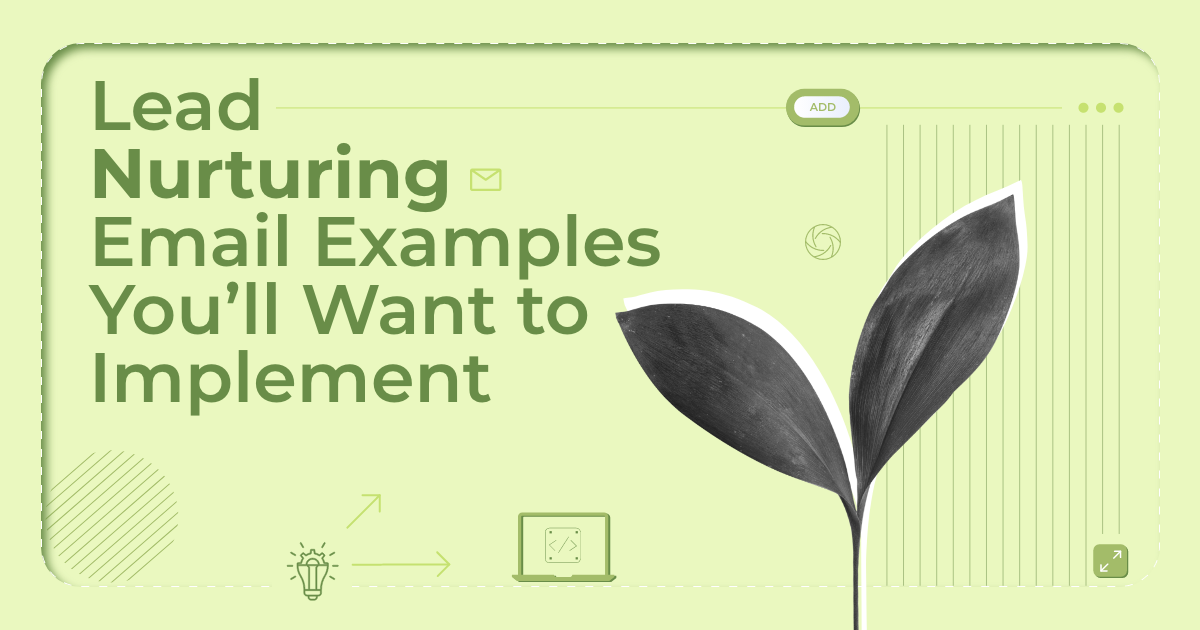
What Is Conversational Marketing? Benefits, Tips & Examples [2025]
Artificial intelligence and related tech advancements have conquered the marketing world for good. Consequently, consumers have raised the bar, opting for brands that provide more human-centric interactions and personalized experiences.
Having a stand-by agent for every visitor who lands on your eCommerce website is impossible, especially when targeting a large audience worldwide. However, it’s important to find ways to follow this stream to keep your customers and prospects satisfied.
And that’s where conversational marketing takes the lead, adding to your existing digital and traditional marketing tactics. Learn how to provide meaningful conversational experiences to customers and build strong relationships.
What Is Conversational Marketing?
Conversational marketing is a dialogue-driven marketing approach that enables users to have real-time conversations with a brand. However, these conversations don’t necessarily need to be conducted by humans on the business side. You can mimic human conversations with software powered by tech advancements, such as Artificial Intelligence (AI), machine learning, NLP, and automations.
These interactions can unfold in different communication channels–chatbots, voice assistants, social media like LinkedIn and Facebook, messaging apps such as WhatsApp and SMS, and emails.
For example, Moosend uses a chatbot inside the website, providing options to visitors in a conversational tone based on frequent requests, giving the opportunity to reach out to an agent for more complex questions:
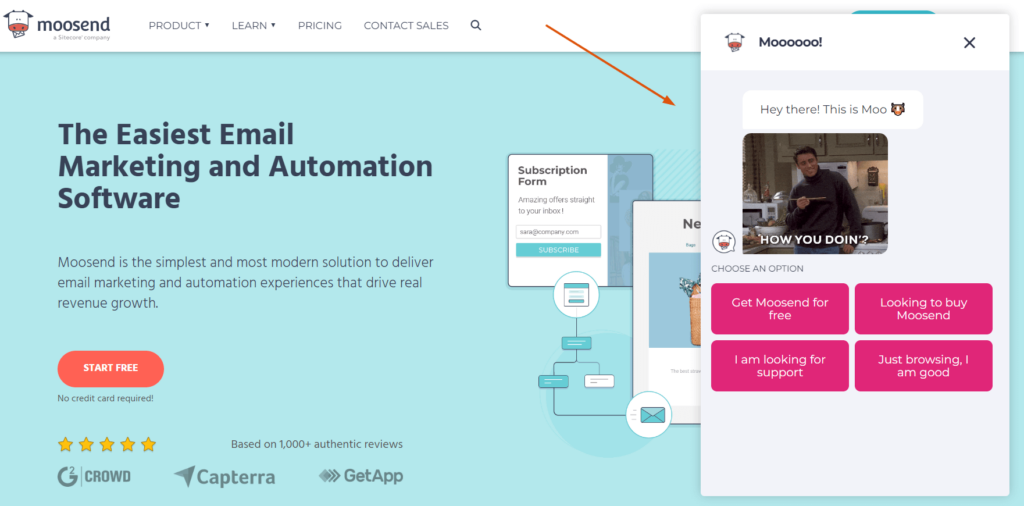
The more sophisticated the tool, the deeper it can go into customer behavior, enabling you to decode customer needs, habits, and interests to deliver personalized experiences.
What a business will resort to depends on many factors like their headcount, goals, and budget. For example, a SaaS company with a large customer base might employ a stellar conversational AI tool like IBM Watson Assistant and Amazon Lex to streamline lots of processes, such as lead generation.
On the other hand, a small business with a limited budget can invest in an Instagram bot. Or they can build email automation workflows, such as abandoned cart emails and product recommendations written in a conversational tone to capitalize on people’s interests.
Examples of Conversational Marketing Use Cases
Let’s explore some of the most popular use cases where you can apply conversational marketing:
- Cross-selling/Upselling: Provide personalized recommendations to customers based on previous purchases or website history.
- Customer support: Address most frequently asked questions and collect information about common customer pain points to resolve them before they turn into tickets.
- Lead generation: Identify qualified leads, provide them with relevant content, and connect with sales when their interest is warmed up.
- Customer engagement: Inform your existing customers about your upcoming sales, offers, and events to keep them satisfied.
- Onboarding: Create a human-like onboarding experience for new customers and set them up for success.
- Customer feedback: Collect feedback from various channels to optimize customer experience and improve your products or services after spotting the challenges your customers face.
This list doesn’t stop here–you can think of multiple ways to foster meaningful conversations with customers based on your business and industry, but these are great for starters.
Why Is Conversation Marketing Important?
Here are some of the top benefits of conversational marketing for businesses. By bringing human-like conversations into your marketing game, you can:
Personalize customer experiences
You need a lot more than scattered social media posts and printed ads these days to attract and delight customers. Consider how many products and services run in front of your current and potential customers’ eyes every day, promising to resolve their biggest problems. You need to go the extra mile to outstand this competition.
Conversational marketing helps create targeted messaging for customers based on the channel they use or the website pages they browse, among other factors. Plus, they can instantly reply to urgent questions or even provide recommendations customers would appreciate having.
Shorten the sales cycle
Having a sales rep interact with every visitor landing on your website is not the most affordable option. Conversational marketing works on your behalf here, too. It tells apart random visitors from leads and qualifies the top ones. Then, it’s time for the sales team to take over.
If you’re searching for new ways to improve your sales process, this digital marketing tactic should be on your bucket list, especially in B2B. With potential customers moving faster down the sales funnel with less headcount needed, you’ll manage to cut down on your expenses and boost your ROI simultaneously.
Get valuable customer insights
Conversational marketing tools can give you a plethora of data to unveil your visitors’ and customers’ behavior. Use it to improve your processes, operations, and products or services as needed. And of course, remember to give yourself a pat on the back for everything that runs smoothly.
Plus, when you combine these insights with analytics from other tools, such as your CRM and email marketing services, you’ll be able to deliver even more targeted marketing messages.
Build stronger customer relationships
Having constructive human-like dialogues in real-time with a brand helps establish long-lasting, trusting relationships. It feels like chatting with a friend who’s always there to listen carefully to your concerns until you start feeling lighter. That’s why it’s important to allow your customers to reach out to you whenever and wherever they want to.
Long story short, conversational marketing will be a bonus to your existing customer loyalty and retention initiatives without having to go the extra mile.
How To Implement a Conversational Marketing Strategy
If you start feeling that this channel should be part of your existing strategy, here are some steps to follow to head to a great start:
1. Set your conversational marketing goals
First, you need a thoughtful and realistic plan. Here are some questions to ask yourself: What would you like to achieve by adding a chatbot or virtual assistant to your existing strategy? What marketing and sales aspects would you like to strengthen and why?
The benefits we shared earlier are great to start with. For example, you can aim at shortening the sales cycle or providing more human-like experiences inside your website to optimize navigation.
Plus, think of channels these customer interactions should take place in based on your buyer personas and average customer journey. Then, map the teams that will engage with this communication channel, the training they’ll need to keep up with this tactic and finally decide on the budget you’d be eager to spend.
2. Choose the right software for your needs
Once you’ve determined your goals, it’s time you searched for a software solution that will help you meet them without breaking the bank. Define the type of software you’ll need based on the tactics you’d like to streamline, such as chatbots, email automation platforms, texting software, etc.
Here are the factors to check out on before purchasing a new tool:
- Features and functionality
- Pricing and scalability
- Integrations with other marketing platforms
- Ease of use
- Customer support
Since chatbots are among the most popular conversational marketing tools, let’s clarify their two main types: rule-based and AI. Rule-based are simpler solutions and work based on predefined rules and decision trees. They are suitable for smaller businesses with shorter sales cycles and simpler customer requests that can usually be addressed as FAQs.
On the other hand, AI chatbots are more complex tools that use machine learning and NLP to carry on more nuanced conversations with customers. Plus, they learn based on previous interactions and become “wiser” over time.
3. Convey your core messaging
Keeping a consistent tone of voice across channels is important to help customers have a unified, persistent idea of your brand and form the right expectations. Knowing your personas and where they usually land on will help you shape your messaging accordingly and provide content and resources that leave a lasting impression.
For example, if you adopt a more friendly and chilled tone as a brand, your conversation marketing tool should do the same. Plus, consider what type of content you’d like to serve to customers and prospects based on their needs. Is it a blog post, a video or podcast? Finally, sync with your team and ensure that they follow the same guidelines.
4. Track and analyze your progress
As with every other marketing channel, you need to monitor important metrics, such as conversion rates, that will reflect how this tactic contributed to your goals. Most conversational software tools offer advanced analytics and reporting capabilities to help you determine what works and what needs refreshing.
Moreover, you can integrate it with your existing marketing stack, such as Google Analytics, to understand its impact on your business. Keep in mind that there’s going to be a testing period until you figure out the types of conversations and resources your customers long for.
5 Top Conversational Marketing Examples from Big Brands
Let’s explore how five big brands used conversational marketing to meet their business goals:
1. Kiehl’s
The popular skincare brand Kiehl’s used conversational marketing to boost their customer engagement and loyalty by providing personalized product recommendations. When you land on their website you can see the chatbot on the right and request expert advice to find the products that suit your needs.
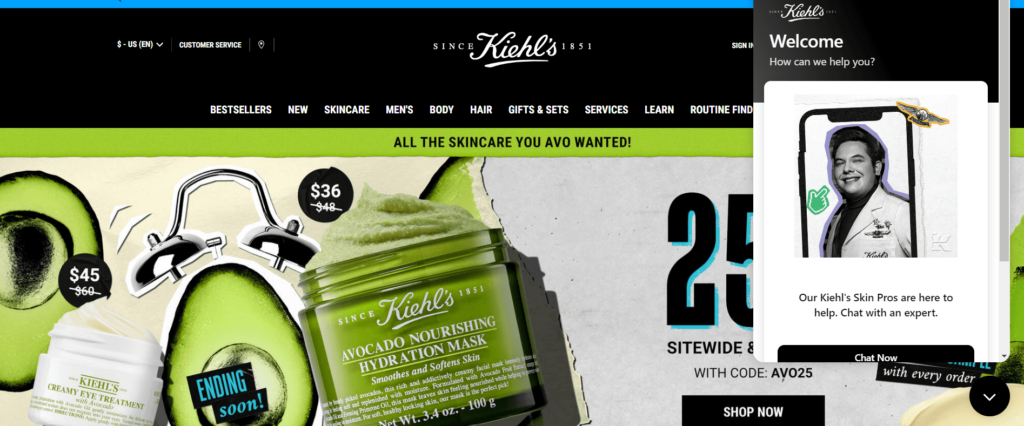
Plus, customers can use the chatbot to check out product availability, find promotions and samples, and view the reward system, among others.
2. KLM Royal Dutch Airlines
KLM introduced its chatbot to cover several customer experience needs. It helps them reduce response times and boost overall satisfaction. Plus, it provides access to important flight information, such as check-in time, and can offer recommendations in a friendly, conversational tone.
They also implemented Google Assistant’s bot to take conversational marketing to the next level powered by AI. Thus, it provides a hard-to-replicate personalized marketing experience to users.
3. Domino’s
Domino’s uses chatbots to improve customer service and help people order easily wherever they are. They connect their chatbots with multiple channels, such as Facebook messenger and Slack. For example, you can place your order following the bot’s instructions and rest assured that it’s on its way through real-time order tracking.
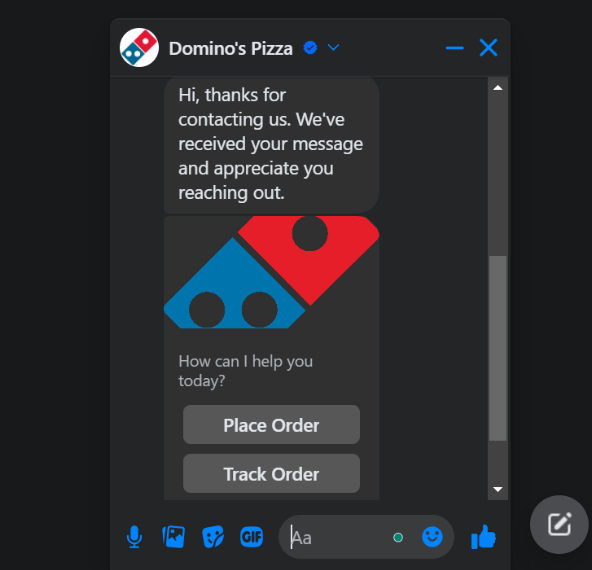
Customers can also use it for support. For more complex questions they are invited to reach out to an agent. Overall, this approach improves customer engagement and simplifies the ordering process, providing extra loyalty bonuses to the brand.
4. OpenTable
Emails or text messages written in a conversational tone can also fit in this category, especially when they’re triggered after a specific customer action and sent in real-time.
For instance, this email by OpenTable informs the recipient that their reservation is cancelled, thanking them for informing them well in advance in a conversational manner.
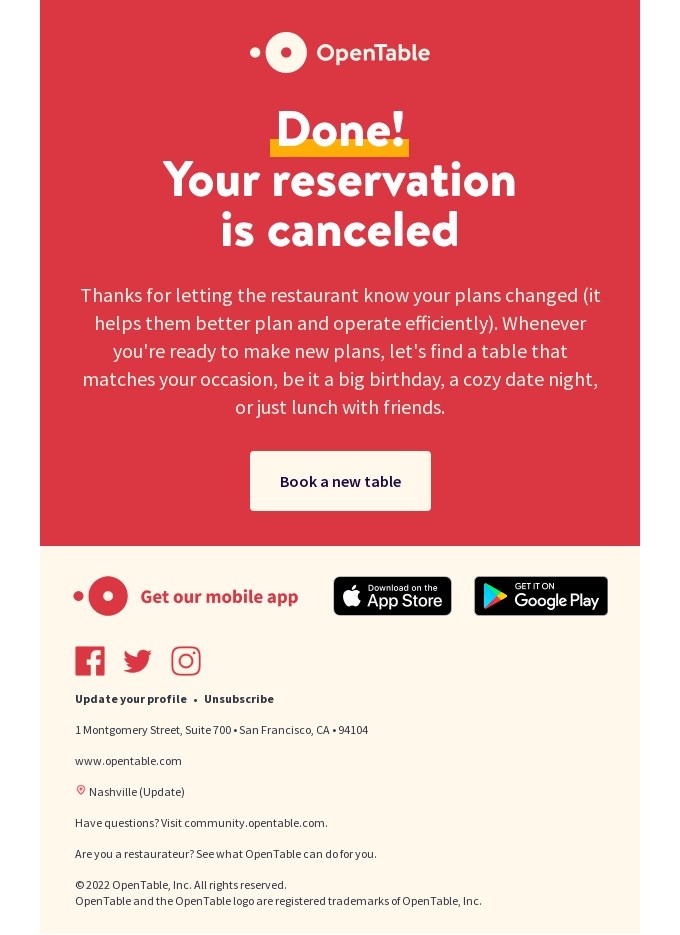
Plus, they’ve placed a CTA button to help them find a new table based on their specific needs.
5. OKTA
OKTA is an employee and customer services solution using their chatbot to start meaningful interactions based on the user’s intent. For instance, it understands different personas based on their browsing history and other factors and initiates relevant conversations.
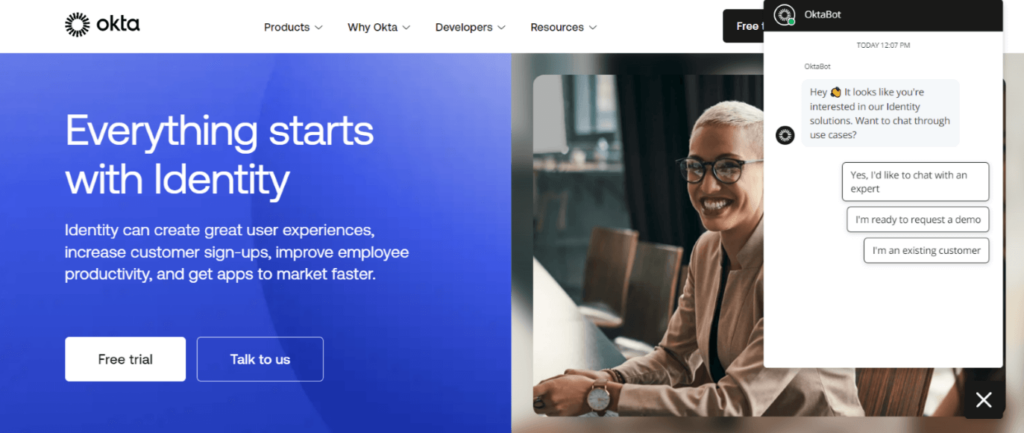
For example, if someone has landed on the customer identity solutions page, this is what will pop up on their screen. After seeing this, leads may move faster down the funnel if they have higher intent.
Uplevel Your Business Through Vivid Customer Conversations
In a nutshell, conversational marketing tools will help you unlock new marketing circuits in different areas. Use real-time interactions to strengthen your inbound marketing, customer support and service and seek additional creative ways to use it.
Sit down with your teammates, write your goals, and search for a user-friendly tool that will help you meet them. Then make sure to attune your chatbot or any other tool you’re using with your brand voice and deliver appropriate content based on where they are at the customer journey.
Looking for a top-notch marketing automation platform to send triggered and personalized emails to customers at an affordable price? Sign up for a Moosend account today and experiment with our features.
FAQs
Before you go, here are the answers to frequently asked questions around our topic:
1. What is an example of conversational marketing?
Chatbots are popular conversational marketing tools marketers use inside their websites to address customer requests in real-time or move them faster down the funnel. Marketing automation and texting tools are also popular.
2. Are conversational AI and chatbots good for customer support?
Yes–they help minimize response times, reduce support tickets, and cut down on unnecessary expenses. Plus, they enable businesses to collect feedback from customers and improve user experience.
3. How can conversational marketing improve lead generation and sales?
Conversational marketing tools can respond based on customer behavior and tell apart leads from random visitors. Then, sales can take over only for qualified leads, shortening the sales cycle.
4. How do you measure the success of your conversational marketing efforts?
Most conversational marketing solutions offer analytics to help you track your metrics. You can also integrate them with your primary performance tool like Google Analytics to gain more in-depth data.
5. What are the types of conversational marketing?
Conversational marketing can be conducted through chatbots, voice assistants, live chatting, messaging apps, SMS, and social media, among others.

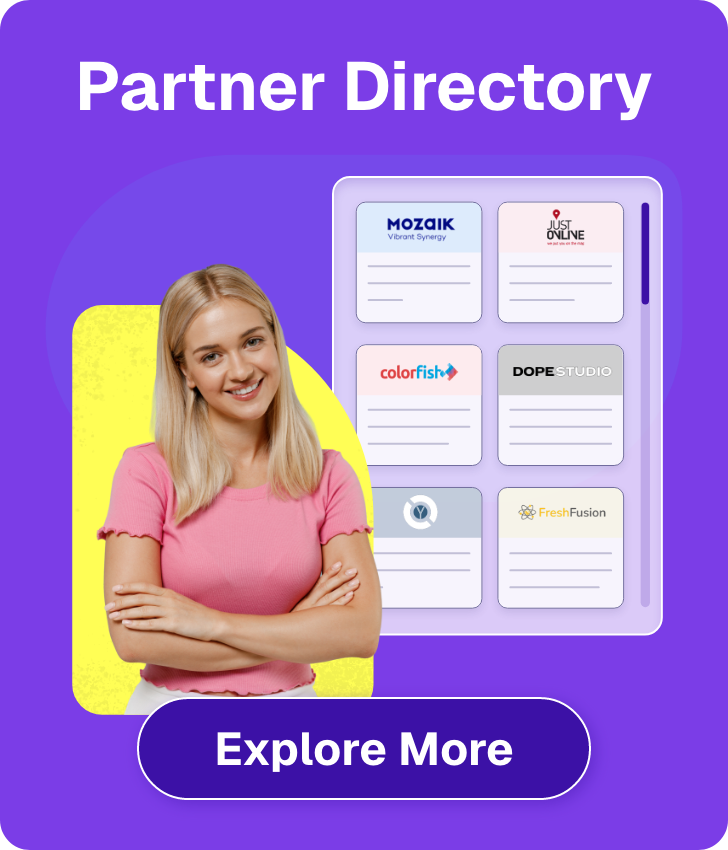

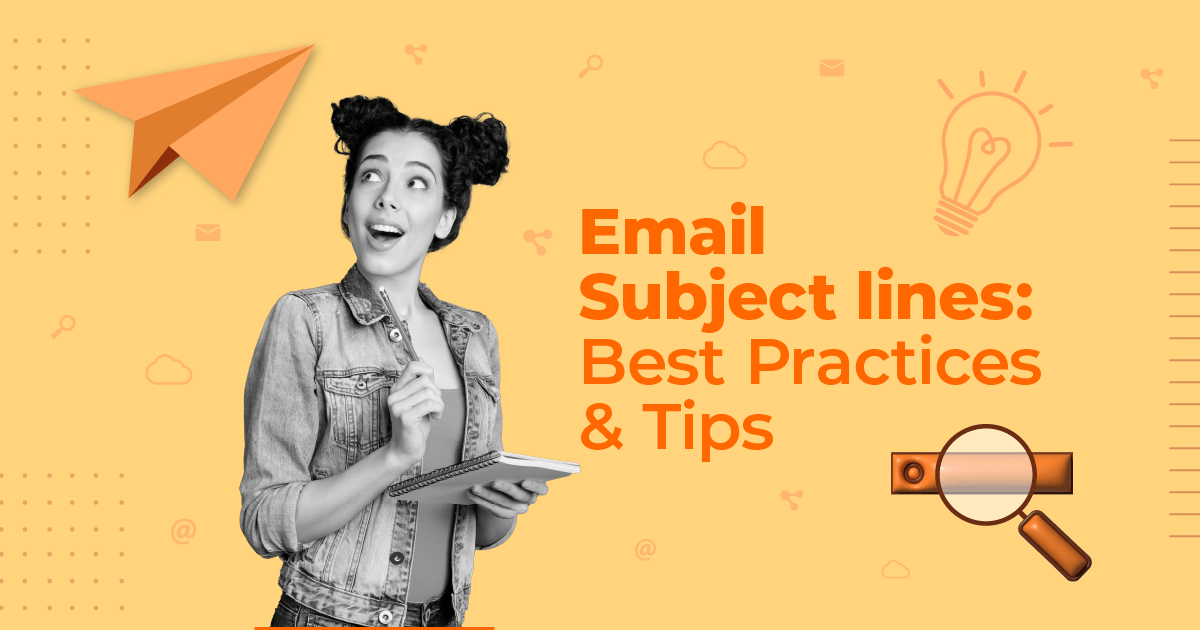
 Published by
Published by

